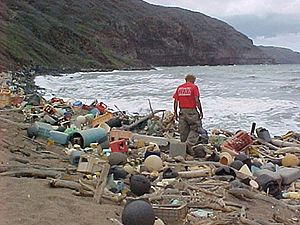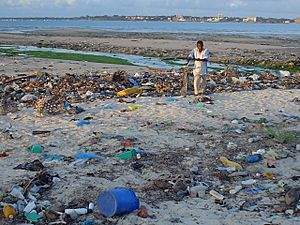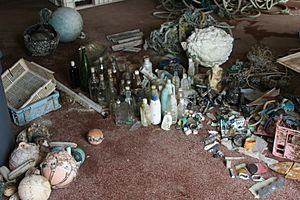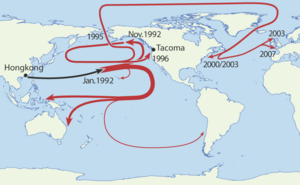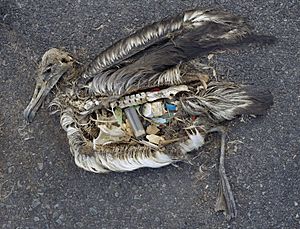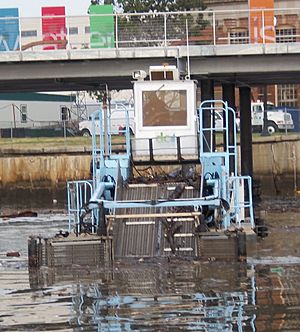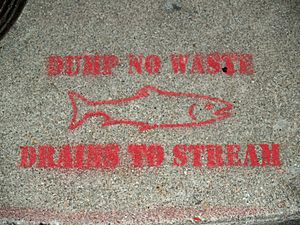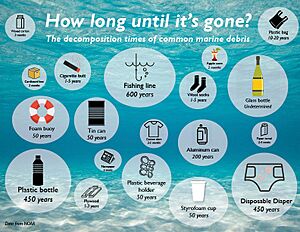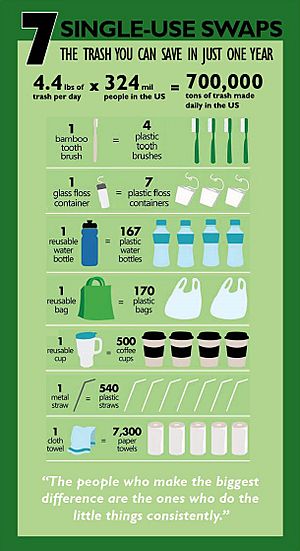Marine debris facts for kids
Marine debris, also called marine litter, is trash made by people that ends up in the sea or ocean. This can happen on purpose or by accident. Floating trash often gathers in the middle of huge ocean currents called gyres. It also washes up on coastlines, where it's known as beach litter. When people purposely throw trash into the sea, it's called ocean dumping. Natural things like driftwood are also found in the ocean, but they are not marine debris.
As we use more plastic, human trash has become a big problem. Many types of plastic do not break down quickly like natural materials do. The biggest type of plastic pollution (about 10%) and most large plastic in the oceans comes from lost fishing nets. Plastic in the water is very dangerous for fish, seabirds, marine reptiles, and marine mammals. It also harms boats and coasts. Trash gets into the ocean from dumping, spills from ships, litter washed into storm drains and waterways, and landfill waste blown by the wind. This increase in water pollution has caused serious problems. These include ghost nets trapping animals, huge areas of plastic trash called marine garbage patches, and more harmful chemicals in the food chain.
To stop and fix marine pollution, countries have made international laws. The United Nations has even made reducing marine pollution a goal for a better future (Sustainable Development Goal 14, "Life Below Water"). Some countries have special rules to protect the oceans. Also, many non-profit groups, charities, and government groups are working to clean up plastic from the ocean. However, in 2017, the UN warned that by 2050, there could be more plastic than fish in the oceans if we don't take big steps to stop it.
What are the Types of Marine Debris?
Scientists divide marine debris into two main types: land-based or ocean-based. In 1991, experts thought that up to 80% of ocean pollution came from land. The other 20% came from big accidents or ships. But newer studies show that more than half of the plastic trash on Korean shores comes from the ocean.
Many different human-made items can become marine debris. Common items found washed ashore include plastic bags, balloons, buoys, rope, medical waste, glass and plastic bottles, cigarette stubs, cigarette lighters, beverage cans, polystyrene, lost fishing lines and nets, and trash from cruise ships and oil rigs. Six pack rings are a well-known example of this problem.
Eighty percent of all marine debris is plastic. Plastics build up because they usually do not break down naturally like other materials. They do break down in sunlight (called photodegradation), but only when dry. Water stops this process. A 2014 study used computers to guess that 5.25 trillion pieces of plastic, weighing 269,000 tons, were spread across the oceans.
Ghost Nets
Macroplastic
Microplastics
Where is Deep-Sea Debris Found?
Most studies have looked at plastic trash on coasts, in surface waters, or eaten by animals living near the surface. But there is less information about trash in the deep parts of the ocean. Scientists study the deep sea using special cameras on robots (ROVs) and submersibles. These studies show that human activities affect the deep ocean. Plastic is often seen in the deep sea, especially near busy areas like the Mediterranean Sea.
Trash made of heavy materials like glass, metals, and some plastics sinks to the ocean floor. There, it can get tangled in coral and harm other sea-floor life. It can even get buried under sand, making cleanup very hard. Plastics that usually float can sink if tiny ocean plants (phytoplankton) or other particles stick to them. Ocean currents and storms also move large amounts of trash to the deep sea. Underwater mountains can also cause currents that trap tiny plastics in certain spots.
The Japan Agency for Marine-Earth Science and Technology (JAMSTEC) created a Deep-sea Debris database in 2017. It shows thirty years of photos and samples of marine debris. From 5,010 dives, they counted 3,425 human-made items. The most common types were large plastics (33%), with 89% of these being single-use plastics. Metal made up 26%. Plastic trash was even found at the very bottom of the Mariana Trench, almost 11,000 meters deep! Plastic bags were also found tangled in special deep-sea communities around hot vents.
Sources of Marine Debris
The top 10 countries that release the most plastic pollution into the ocean are China, Indonesia, Philippines, Vietnam, Sri Lanka, Thailand, Egypt, Malaysia, Nigeria, and Bangladesh. Most of this plastic comes from major rivers like the Yangtze, Indus, and Nile. These rivers carry about 90% of all plastic that reaches the world's oceans.
About 10,000 shipping containers are lost at sea each year, usually during storms. One famous spill happened in the Pacific Ocean in 1992. Thousands of rubber ducks and other toys (now called the "Friendly Floatees") fell overboard. These toys have since been found all over the world. This helped scientists learn more about ocean currents. Other spills have also happened, like when the Hansa Carrier lost 21 containers, one filled with floating Nike shoes. In 2007, the MSC Napoli ship got stuck in the English Channel, losing hundreds of containers. Most of these washed up on the Jurassic Coast, a famous World Heritage Site. A 1997 accident involving the Tokio Express ship off the British coast lost a container with 5 million Lego pieces. Some of these pieces became valuable to collectors who searched beaches for Lego dragons. This also gave scientists important information about how plastic breaks down in the ocean.
In Halifax Harbour, Canada, 52% of trash came from people using a city park. Only 7% came from shipping and fishing. About four-fifths of ocean trash comes from garbage blown into the water from landfills and from urban runoff (water flowing off city streets).
Some studies show that marine debris can be very common in certain places. For example, a 2016 study in Aruba found that most trash on the windy side of the island came from far away in the ocean. In 2013, trash from six beaches in Korea was studied. 56% was "ocean-based" and 44% was "land-based."
In 1987, medical waste washed ashore in New Jersey after being blown from a landfill. This event was called the Syringe Tide. On the remote island of South Georgia, fishing trash (about 80% plastic) causes many Antarctic fur seals to get tangled. Marine litter is even found on the bottom of the Arctic Ocean.
What are Garbage Patches (Gyres)?
How Does Marine Debris Affect the Environment?
Not all human-made things in the ocean are harmful. Structures made of iron and concrete usually sink and stay put. In shallow water, they can even become artificial reefs, providing homes for sea life. Ships and subway cars have been purposely sunk for this reason.
Also, hermit crabs have been known to use pieces of beach trash as a shell if they cannot find a real seashell that fits.
Impacts from Plastic Pollution
Many sea animals accidentally eat floating trash because it often looks like their natural food. In total, 1288 marine species are known to eat plastic debris, with fish being the largest group. Large plastic pieces can get stuck in an animal's stomach, blocking food and causing death from starvation or infection. Tiny floating plastic bits also look like zooplankton, which can lead filter feeders (animals that strain food from water) to eat them. This causes plastic to enter the ocean food chain.
How is Marine Debris Removed?
Coastal and River Cleanups
One way to collect and remove marine or river trash is by using special boats called debris skimmers. These boats are used where floating trash could be dangerous for other boats. For example, the US Army Corps of Engineers removes 90 tons of "drifting material" from San Francisco Bay every month. They have done this since 1942, after a seaplane carrying Admiral Chester W. Nimitz hit floating trash and sank. The Ocean Cleanup project has also created a boat called the Interceptor to clean up river trash. Once trash washes onto beaches, people collect it by hand or use special beach-cleaning machines.
There are also projects that encourage fishing boats to remove any trash they accidentally catch while fishing.
In other places, "trash traps" are put in small rivers to catch waterborne trash before it reaches the sea. For example, South Australia's Adelaide uses "trash racks" on the Torrens River to stop pollution.
In lakes or near the coast, people can also remove trash by hand. Project AWARE encourages dive clubs to clean up trash underwater as a diving exercise.
Once a year, there is a diving marine debris removal operation in Scapa Flow in the Orkneys. This is run by Ghost Fishing UK and funded by World Animal Protection.
Cleaning up marine debris can be hard because different government groups are in charge of different areas (ocean surface, seabed, shore). For example, there are about 1600 abandoned boats in British Columbia, Canada. In 2019, Canada made it illegal to abandon a boat. But it's hard to make people follow this law because it's often difficult to find out who owns an abandoned boat. This means abandoned boats are often left to sink, which costs more to clean up and adds to pollution.
Mid-Ocean Cleanups
Cleaning up artificial trash (like plastics) in the open ocean is still quite new. However, some projects have started using ships with nets to catch plastics, mainly for research. There are also ideas for solar- and wind-powered ships with shredders and cargo holds, like Bluebird Marine System's SeaVax and The Sea Cleaners' Manta ship.
Another idea for gathering ocean trash comes from The Ocean Cleanup's Boyan Slat. He suggested using platforms with long arms to collect trash inside the ocean gyres. The SAS Ocean Phoenix ship has a similar design.
In June 2019, the Ocean Voyages Institute cleaned up the North Pacific Subtropical Convergence Zone. They used GPS trackers and existing ship equipment. They set a record by removing over 84,000 pounds of plastic nets and consumer plastic trash.
In May/June 2020, the Ocean Voyages Institute set a new record. They removed over 170 tons (340,000 pounds) of consumer plastics and ghostnets from the ocean. They use special GPS satellite trackers to find ghostnets and send cleanup ships to them. They are also combining this with satellite images to find plastic trash in real-time, which will make cleanups much more effective.
However, removing marine debris from the ocean can sometimes cause more harm than good. Cleaning up tiny plastics (microplastics) could accidentally remove plankton. Plankton are the main food source for many sea animals and produce over half of the oxygen on Earth. One of the best and cheapest ways to reduce plastic in our oceans is to avoid using single-use plastics. This means not buying plastic water bottles, using reusable shopping bags, and choosing products with reusable packaging.
What Laws and Treaties Help?
The ocean is a shared resource for everyone. So, the negative effects of marine debris are not usually felt by the people who create the trash. In the 1950s, countries realized that governments needed to get involved to control ocean pollution.
Ocean dumping is controlled by international law, including:
- The London Convention (1972) – a United Nations agreement to control ocean dumping. This agreement listed many harmful substances that should not be dumped into the ocean, such as mercury, lead, and radioactive wastes.
- MARPOL 73/78 – a convention made to reduce pollution of the seas, including dumping, oil, and exhaust pollution. The original MARPOL agreement did not cover dumping from ships, but it was changed in 1978 to include rules for marine vessels.
- UNCLOS – signed in 1982 and started in 1994. This agreement stressed the importance of protecting the entire ocean, not just coastal areas. UNCLOS put limits on pollution, especially from land-based sources.
Laws in Australia
One of the first laws against dumping was Australia's Beaches, Fishing Grounds and Sea Routes Protection Act 1932. It stopped ships from throwing "garbage, rubbish, ashes or organic refuse" into Australian waters without permission. This law was made because a lot of trash was washing up on the beaches of Sydney and Newcastle. This trash came from ships that local governments could not control. The law was later replaced by the Environment Protection (Sea Dumping) Act 1981, which put the London Convention into effect.
Laws in Europe
In 1972 and 1974, meetings in Oslo and Paris led to the OSPAR Convention. This is an international agreement that controls marine pollution in the north-east Atlantic Ocean. The Barcelona Convention protects the Mediterranean Sea. The Water Framework Directive of 2000 is a European Union directive. It requires EU member states to clean up their inland and coastal waters from human pollution. In the United Kingdom, the Marine and Coastal Access Act 2009 aims to make oceans and seas clean, healthy, and full of life. In 2019, the EU parliament voted to ban single-use plastic products across the EU. This includes plastic straws, cutlery, plates, drink containers, and plastic carrier bags. This law will start in 2021.
Laws in the United States
In the waters of the United States, pollution has caused many problems. These include areas with low oxygen (hypoxic zones), harmful algae blooms, and endangered species. In 1972, the United States Congress passed the Ocean Dumping Act. This law gave the Environmental Protection Agency the power to control the dumping of sewage, industrial waste, radioactive waste, and dangerous biological materials into US waters. The law was changed sixteen years later to include medical wastes. It is now illegal to throw any plastic into US waters.
Who Owns Found Items?
Laws about property, admiralty law (laws of the sea), and the law of the sea can apply when lost items are found at sea. Salvage law gives rewards to people who risk their lives and property to rescue someone else's property from danger. In the United Kingdom, items found from shipwrecks must be reported to a "Receiver of Wreck." If the owner can be found, the items should be returned to them.
Activism Against Marine Debris
Many groups and people are working to prevent marine debris or teach others about it. For example, 5 Gyres is an organization that aims to reduce plastic pollution in the oceans. They have researched the Great Pacific Garbage Patch. Heal the Bay is another group that protects California's Santa Monica Bay. They organize beach cleanup programs and other activities. Marina DeBris is an artist whose recent work focuses on teaching people about beach trash. Interactive websites like Adrift show how ocean currents carry marine plastic over time.
On April 11, 2013, artist Maria Cristina Finucci created The Garbage patch state at UNESCO in Paris to raise awareness. This was the first of many events supported by UNESCO and the Italian Ministry of the Environment.
Forty-eight plastic manufacturers from 25 countries are part of the Global Plastic Associations for solutions on Marine Litter. They have promised to help prevent marine debris and encourage recycling.
How Can We Help?
Marine debris is a problem caused by all of us, not just people living near the coast.
Plastic trash from inland states comes from two main sources: regular litter and materials from open dumps and landfills that blow or wash into rivers and wastewater. This trash then travels from inland waterways, rivers, streams, and lakes to the ocean. Cleaning up oceans and coasts is important, but we also need to stop plastic waste from reaching the water in the first place.
Here are some ways to reduce the amount of trash entering our waterways:
- Improve how waste is moved to and from sites by using closed containers for storage and shipping.
- Limit open waste facilities near waterways.
- Encourage the use of Refuse-derived fuels. Used plastic that is hard to recycle can be turned into fuel for power plants. This gives the plastic another use instead of ending up in landfills or the ocean.
- Improve how much plastic is recycled. In 2012, the United States created 11.46 million tons of plastic waste, but only 6.7% was recycled.
- Use Extended Producer Responsibility plans. These make companies responsible for managing their products and packaging after they become waste. This encourages them to design products that can be reused.
- Ban cigarette filters and create a system for recycling e-cigarettes (like how propane tanks are recycled).
You can help reduce plastic in waterways by using fewer single-use plastics, avoiding products with microbeads, and joining a river or beach cleanup.
How Has COVID-19 Affected Marine Debris?
In Kenya, the COVID-19 pandemic changed the amount of marine debris found on beaches. About 55.1% of the trash found was related to the pandemic. Even though this pandemic-related trash appeared on beaches, it did not seem to reach the water. This might be because beaches were closed and people moved around less during the pandemic, so less trash ended up in the ocean. Other effects of the COVID-19 pandemic have been seen in Hong Kong. Disposable masks have washed up on the beaches of Soko’s islands. This could be due to the increased production of medical products (like masks and gloves) during the pandemic, leading to more people throwing them away improperly.
See also
 In Spanish: Desechos marinos para niños
In Spanish: Desechos marinos para niños


